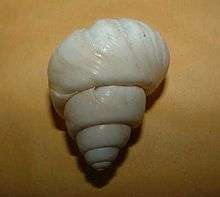Neothauma
| Neothauma | |
|---|---|
 | |
| shell of Neothauma tanganyicense | |
| Scientific classification | |
| Kingdom: | Animalia |
| Phylum: | Mollusca |
| Class: | Gastropoda |
| (unranked): | clade Caenogastropoda informal group Architaenioglossa |
| Superfamily: | Viviparoidea |
| Family: | Viviparidae |
| Genus: | Neothauma E. A. Smith, 1880[2] |
| Species: | N. tanganyicense |
| Binomial name | |
| Neothauma tanganyicense E. A. Smith, 1880[2] | |
Neothauma tanganyicense is a species of freshwater snail with a gill and an operculum, an aquatic gastropod mollusc in the family Viviparidae.
This is the only species in the genus Neothauma.[3][4]
Distribution
This freshwater snail is only found in Lake Tanganyika, where it is the largest gastropod, and occurs in all four of the bordering countries — Burundi, the Democratic Republic of the Congo, Tanzania, and Zambia — although fossil shells have been discovered at Lake Edward and in the Lake Albert basin.[1]
The type locality is the East shore of Lake Tanganyika, at Ujiji.[4]

History

The genus Neothauma previously contained several species, but most were reassigned to other genera.[5]
Description
The width of the shell is 46 mm.[4] The height of the shell is 60 mm.[4]
Ecology
This species lives in depths of up to 65 m.[4]
The shells of dead Neothauma tanganyicense often form carpets over large areas, and are used by a number of other animals, such as cichlid fish (shell dwellers),[6] and freshwater crabs of the genus Platythelphusa.[7] Juvenile snails live in the sediment in order to avoid predators.[4]
References
- 1 2 F. Nicayenzi, C. Ngereza & C. N. Lange (2004). Neothauma tanganyicense. In: IUCN 2008. IUCN Red List of Threatened Species. Retrieved August 7, 2007.
- 1 2 Smith E. A. (1880). "On the shells of Lake Tanganyika and of the neighbourhood of Ujiji, central Africa". Proceedings of the Zoological Society of London 1880: 344-352. Page 349. Plate 31.
- ↑ Mita E. Sengupta, Thomas K. Kristensen, Henry Madsen & Aslak Jørgensen (2009). "Molecular phylogenetic investigations of the Viviparidae (Gastropoda: Caenogastropoda) in the lakes of the Rift Valley area of Africa". Molecular Phylogenetics and Evolution 52 (3): 797–805. doi:10.1016/j.ympev.2009.05.007. PMID 19435609.
- 1 2 3 4 5 6 Brown D. S. (1994). Freshwater Snails of Africa and their Medical Importance. Taylor & Francis. ISBN 0-7484-0026-5.
- ↑ Bourguignat, Jules René (1888-01-01). Iconographie malacologique des animaux mollusques fluviatiles du Lac Tanganika (in French). Impr. Crété.
- ↑ Stephan Koblmüller, Nina Duftner, Kristina M Sefc, Mitsuto Aibara, Martina Stipacek, Michel Blanc, Bernd Egger & Christian Sturmbauer (2007). "Reticulate phylogeny of gastropod-shell-breeding cichlids from Lake Tanganyika — the result of repeated introgressive hybridization". BMC Evolutionary Biology 7: 7. doi:10.1186/1471-2148-7-7. PMC 1790888. PMID 17254340.
- ↑ N. Cumberlidge, R. von Sternberg, I. R. Bills & H. Martin (1999). "A revision of the genus Platythelphusa A. Milne-Edwards, 1887 from Lake Tanganyika, East Africa (Decapoda: Potamoidea: Platythelphusidae)". Journal of Natural History 33: 1487–1512. doi:10.1080/002229399299860.
